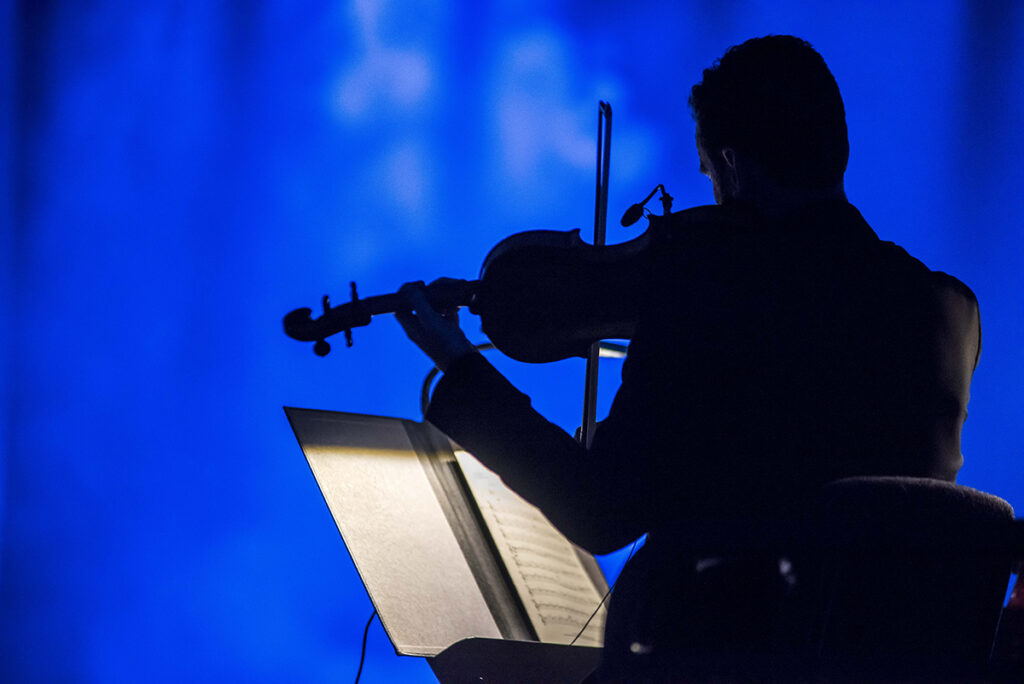I do not know and am not qualified to say if Huang Ruo’s newly commissioned piece, “City of Floating Sounds,” is a great work of music. What I do know and can say, with gratitude and certainty, is that the event the ‘composer and conceptual artist’ has created (in collaboration with the BBC Philharmonic and ‘creative technologist,’ Josh Kopeček) now ranks alongside the most treasured aesthetic experiences of my life.
Manchester weather is unusually kind as 50 or so of us gather in Sackville Gardens (other groups are gathering in Peel Park, Ordsall Park and Cathedral Gardens) for the first part of the event – a stroll through the city centre, headed for Aviva Studios (the location for part two).
Although a reasonably up-to-date smart phone is recommended (to download the “City of Floating Sounds” app – to hear music as we walk and have access to the map), you will be able to get by without it. Just turn up, follow Factory International’s patient, efficient and friendly guides, tag along with the group (you’ll be able to hear the digital music from their phones, as you walk). Do chat with strangers along the way. It’s part of the fun, and some of them you’ll no doubt bump into later.

Our route takes us through the Gay Village, towards the Central Library, around by Manchester Central, pausing for stragglers in St John’s Gardens, onwards, via Deansgate, to the concert hall (with ample time to grab a drink and reflect).
If the rebel lurks within you, there is no need to follow the route and stick with the gang. By all means find your own way (or, even skip part one and go straight to Aviva Studios). Similarly, if you don’t feel up to the 30 minute walk (entirely on the flat), use the digital map to choose a point along the way to meet up with the group. Your own way is the right way. That said, I strongly recommend sticking with the group, if you are able.
As we walk, digital music plays from each of our phones. Intrigued passers by stop and ask what’s happening. The guides do their best to keep us safe (this is Manchester at commuting time). Even so, a pleasant woman, hefty rucksack on her back, plays “Chicken” with a tram approaching St Peter’s Square. (She wins, though I think the kindly tram driver let her).
Besides trams, we pass buses, impatient commuting drivers honking, an ambulance or two with sirens sounding, a man pushing a rattling trolley loaded with water cooler refills, punters chatting and laughing in street-side bars – all those regular sounds of a vibrant, busy city. With the music rising and falling in our ears, it is as though we are walking through the opening-credit scene of some Hollywood movie set in this fine English city.
Having, questioningly but eagerly, followed our “leaders” and their music on this beautiful evening, just like the children of Hamelin, we disappear – not into a mountainside, but into the comparative gloom of Aviva Studios.
After pausing for a drink, and to reflect on what we’ve experienced, we are invited up into the auditorium. (There is an escalator and a lift, for any with mobility issues). The hall itself is stripped of seating (apart from relatively few, free-standing chairs, set out in twos and threes).
Notably hazed and lit only gently from the backdrops framing the space, the eye is immediately draw to musicians (real live human beings with instruments): an orchestra, raised on metal platforms, perhaps a metre and a half high. The various sections (string, woodwind, brass) are set apart as they would be in a conventional concert, only the groupings are smaller (duos, trios, the occasional quartet).

Standing alone, on her very own platform and, necessarily, more starkly lit, is conductor, Gemma New, who is about to lead her players (and ourselves) into a wondrous new species of musical theatre: musicians and audience moving together to create a unique theatrical performance.
This concert lasts 40-45 minutes. I sit for the first 25 minutes, listening, and watching my fellow audience members (some of them now not quite strangers) standing or strolling among the musicians on their platforms. Some are studious; some captivated, almost dazed; others, not quite getting it, chat and joke, as in some swish new bar where music is mere incidental background for their conversation. One man circulates, a tiny baby fastened in a sling on his chest. Next to me, a woman sips from a beaker, ice cubes rattling. And everywhere, the muffled sound of perambulating human feet.
All the while, Ruo’s score – minimalistic, caressing, eastern influences blending with western – soars above and around the “noise;” a broadly flowing river of crafted melody and harmony, running alongside the ceaselessly babbling stream of random human motion.

Time for me to take a stroll through the throng. People spy friends, unexpectedly. They hug and laugh, exchanging their enthusiasms. A few small children wander, quietly engrossed, as though exploring some sonic playground, built especially for them. One woman, eyes closed, sways and dances, just like this is Woodstock ’69. And there is my new friend, the tram-dodger, rucksack still in place, smiling and nodding approvingly. Smiles, warm or semi-beatific, are the currency of the evening.
Photographs (no flash, please) are permitted, not video. Take a few but, please just Be Here Now. Stand close by as many of the platforms as you can, to hear the contribution of each section (how few of us have had this opportunity!) Two platforms each are peopled by cellists and double bassists – from up close, their deep tones vibrate delectably. Brass and woodwind sing in ways you might never again get to hear.
After Saturday, “City of Floating Sounds” transfers to New York City’s Lincoln Center.
Go now, if you can.
Huang Ruo: City of Floating Sounds is at Aviva Studios from 6-8 June 2024.





